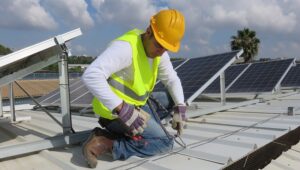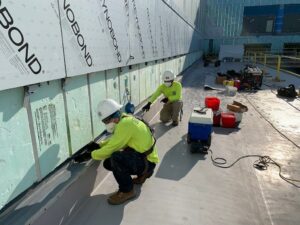Window cleaning is a challenging chore, but it must be done to keep your home looking pristine. Window Cleaning Sarasota helps ensure your windows are clean and streak-free.
Before washing the windows, use a cloth or paper towel to wipe down any loose dirt or dust. Leaving loose gunk on the frames can scratch them and lead to water spots and streaks. Also, wooden frames need to be dried thoroughly after washing to prevent moisture damage; too much water can cause them to swell or even rot.

Next, mix up a solution of mild dish soap or a specialist cleaner such as biological wash powder with warm water. Dip a soft sponge or rag in the solution and wring it out gently (not so wet that the frame is soaking). Wipe down the frames, paying special attention to any crevices where dirt tends to accumulate. If you’re struggling with stubborn grime or stains, a little more pressure or a scrub brush may be required. If you have a wood-safe product, like Bar Keepers Friend or Zud, that contains oxalic acid, it can be very effective at dissolving organic stains and marks.
Wooden window sills can become prone to oxidation, which causes them to appear dull and yellow. If a normal cleaning doesn’t work, try pouring equal parts white vinegar and water into a bucket. The vinegar will help break down the oxidation, and the cleansers in the solution will make it easier to remove any residue.
If you have double-hung windows, they can be tilted inward for easy access to the inside of the frames. For non-double hung windows, unlatch the sash at one end and open it about 8 inches for cleaning. If you have a traditional sash window, the bottom internal bead is usually fixed and can’t be tipped inward.
Lastly, using a lint-free cloth or paper towel, dry the window frame thoroughly. Start with the top of the frame, and then move downwards to avoid any drips on the cleaned glass. Once all the corners and nooks are dry, your windows are done! Streaks often occur when you’re drying the glass, so always work from the top down to avoid leaving streaks. Also, remember to wipe the edges of the glass with a clean part of the lint-free cloth to prevent them from sticking to the glass.
When it comes to cleaning glass, the right cleaner and technique make all the difference. Use a commercial glass cleaning solution that promises not to leave streaks; a homemade vinegar and water mixture works well too. Before you start wiping, spray the surface with your cleaning solution, focusing on any spots or areas that need more attention. Leave the cleaner to soak on the surface for 15 minutes or more, depending on the level of dirtiness. This gives the cleaner time to break down and dissolve stubborn dirt and grime, leaving behind a smooth finish.
When you’re ready to wipe, choose a clean, lint-free cloth. Paper or microfiber cloths are best for a streak-free shine, but you can also use special wood rags that are made to absorb moisture without leaving lint. Avoid plain cotton towels, which can leave behind unsightly marks.
Start from the top of the window and wipe in a “S” pattern, Fisk says. This method allows you to cover more surface area more quickly and reduces the likelihood that the cleaner will dry on the glass, which can cause streaking.
To eliminate streaks completely, invest in a squeegee. This tool is a necessity if you plan on cleaning tall windows or shower doors, and it can also be helpful in removing smudges from flat surfaces such as mirrors and glass tabletops. To avoid teetering on a ladder, a long-handled squeegee may be more comfortable to use.
Once you have a squeegee, test it out by running it over the edge of a clean strip of glass near one of the corners. This will help you learn how to properly position the blade for maximum effectiveness and minimize drips and streaks. When you’re ready to start cleaning, begin at the corner closest to the top of the window and work your way down.
If your glass is particularly dirty, consider pre-soaking it with a homemade degreaser before you wash it with your favorite commercial or homemade cleaner. This method removes the toughest stains, such as those caused by hard water or greasy fingerprints. Mix equal parts white vinegar and water, or add a tablespoon of dishwasher soap to the vinegar mixture. The sodium lauryl sulfate in the soap helps to dissolve grease.
If your windows have screens, remove them and wash them in the same manner as you would a window pane. Work with one screen at a time to avoid damaging the frames and use a lint roller to keep them clean between cleanings.
For a more thorough cleaning, wet the screen and apply a solution of vinegar and water or a commercial window cleaner. Work the solution into the corners and crevices of the screen with a sponge or brush bristle. If necessary, you can also scrub the screen with a bristle brush or a nonmetal scraper, but do so carefully to avoid scratching the glass.
When the screen is clean, let it dry thoroughly before replacing it in the window frame. If the screens are particularly dirty, consider letting them soak in a bucket of vinegar for about 30 minutes to eliminate stubborn dirt or grime.
As with the glass, you should wipe down the frames, starting with the inside and moving to the outside. If your frames are painted, you should first apply a coat of protective varnish to the surface to prevent scratching.
Once you have removed any loose dirt and debris from the frame, finish wiping it with a damp, lint-free cloth. A microfiber cloth is best, as it will not leave a film and is more absorbent than paper towels or old rags.
For higher windows, you can spray the cleaner on the window and spread it with a clean rag or mop. However, be careful to avoid spraying the edges or non-glass surfaces as they may be damaged by overspraying. Finally, dry the windows, starting at the top and working down to avoid drips. A squeegee is ideal for this task but, if you don’t have one, a rubber-bladed broom or a clean rag will also do the trick. If you live in a rainy area, consider using a rain-repellent treatment on the window, as they cause water to bead and roll off rather than soaking into the glass.
When glass is wet, it must be dried promptly to prevent water spots and streaks. The most common method is to use a clean cloth, but it’s important that the cloth is lint-free and absorbent. Paper towels and even non-microfiber cloths can leave globs of disintegrating paper or lint behind, which will create streaks on the window. Microfiber cloths like those from Casabella have a special honeycomb texture that nabs water spots, smudges and dirt without scratching the glass or leaving lint.
If the windows are especially dirty, they may need to be rinsed with a soft brush or a sponge dampened with cleaning solution or mineral deposit remover. This is most often required for windows in studios or homes that are prone to smudges from ceramic work, mold making and shelf prepara-tion, metal shavings, wood chips and other industrial materials.
To prevent the buildup of water spots and streaks, it’s best to wash windows when the sun isn’t shining directly on them. The sun’s heat speeds up the drying of the washing solution, which can cause streaking. It’s also best to wash a single window at a time, rather than trying to clean several windows in a row.
After wiping away the soapy residue with a lint-free cloth or towel, wipe the window dry with another clean, lint-free cloth. This will make sure that all the cleaning solution is removed from the window. For windows that have a lot of condensation, use a dew-removal spray to help loosen and release it.
For hard-to-reach windows or those in a high position, it’s a good idea to invest in a telescoping squeegee with a swivel head and extension. This allows you to wash the windows without teetering on a ladder. It’s also a great way to get those tricky windows between the sash and frame. For stubborn stains, such as bird droppings or tree sap, try using a razor blade mounted in a squeegee holder to scrape them off. Be careful, though, as this can scratch tempered glass and may require resurfacing. If the stains are too severe, it’s better to soak the window in a bucket of cool water and then scrub it with an appropriate abrasive cleaner.


